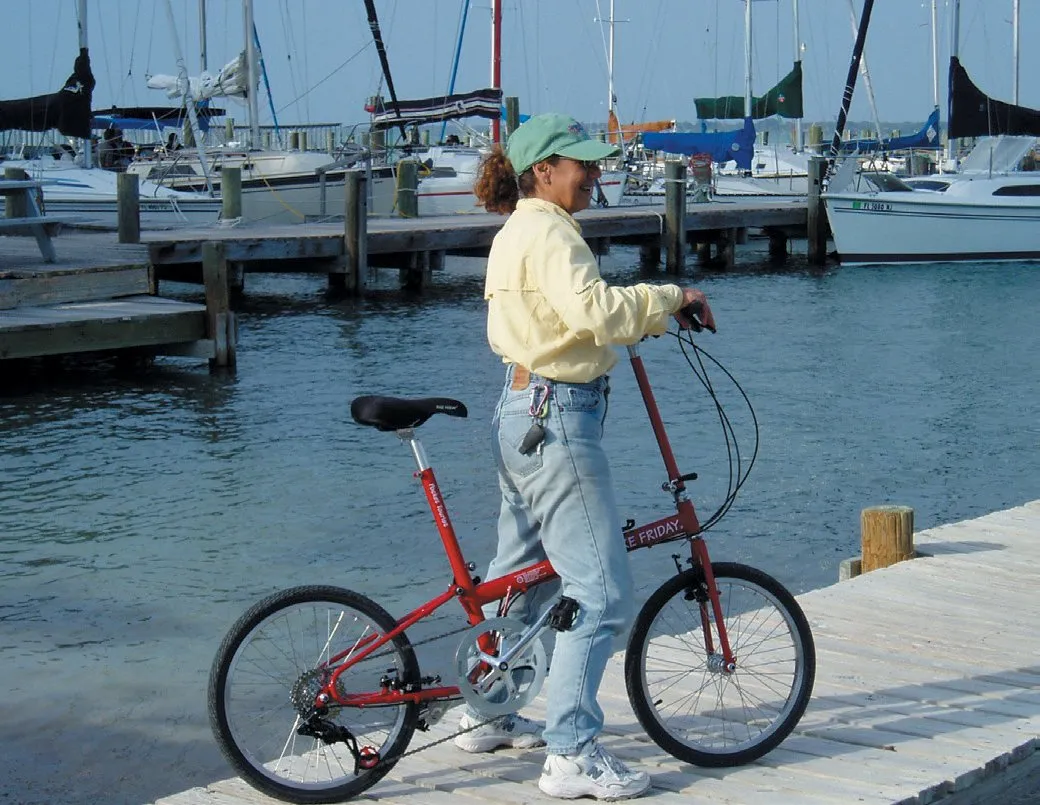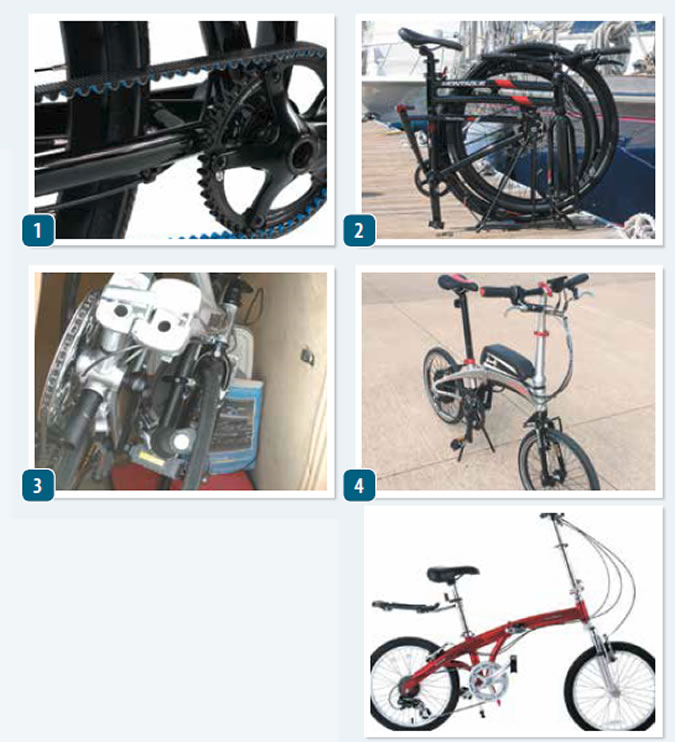One of the blessings of a multihull is its wide expanse of deck space that opens up possibilities that you might not consider on a monohull-like a bike rack. No, you don’t want to cross the Atlantic with a ye ol Raleigh strapped to the pulpit, but for bay cruising, a rack will work-especially on a multihull.
Folding bikes are great (see adjacent story), but conventional bikes are cheaper, and since we’re staying close to home, do we really want to buy another bike? Finally, kids and guests don’t have folding bikes. With a rack they can bring what they have and are accustomed to. Folding bikes have their place, but a bike rack can provide alternatives.
We’ve seen racks on the stern quarter, just barely out of the way of the spinnaker sheets. The bikes must come off and the rack arms lowered for docking. However, the users stayed on the hook most of the time. Even heeled hard over, the wheels stayed dry, since spray and water don’t often come over that quarter.
Are the bikes safe in a storm? While breaking waves in a serious storm might pose a risk to both the bikes and the railing they are attached to (take the wheels off and store the bikes below for the duration), ordinary brisk weather and squalls are no concern. Bike racks are made to withstand highways speeds and potholes. Just secure the bikes as you would on your car.
Curiously, there are few marine bike rack products to choose from, and few targeted at sailboats. But as avid cyclists, we didn’t let that stop us.
DIY Rack
We didn’t start from scratch. Although we had a shed full of racks we didn’t use anymore, they weren’t quite what we wanted. We liked the original Rhode Gear Shuttle, because it folded flat and because we could easily modify it. Although it is no longer in production, it may have been the most popular model ever, and as a result, they are common on the overstock and secondhand market. We paid $12, but we see many listed for $25-40.
The arms, upper, and lower braces all meet in a notched swivel joint. Remove the upper arm, which would normally brace against the rear window of the car, and replace it with a pair of hooks to fit over the stern rail. We cut ours from 3/4-inch exterior plywood and kept them painted, but they could be bent from tubing or cut from fiberglass sheet. The lower leg brace rests against a stanchion. Straps anchor to the stanchion base. The resulting rack is very light, compact, secure, and quite stiff.
Bikes are lashed on in the customary manner. Initially, we added some extra straps in the most violent weather, but we soon realized that the motion of a boat is less violent that a car and the extra straps weren’t needed.

Assembly caution: The Bike Friday allowed the removable handlebar to be installed with the front forks reversed, leaving the bank unbalanced. Other bikes we tested had slotted guides or other features to prevented this common assembly mistake.
Cyclegrip
Featuring a notched pivot similar to the old Rhode Gear Shuttle line, it is easy to adjust and sturdy. If you have a swim platform it may be a drop-in solution.
Bottom line: We’ve seen them on power boats, but not on sailboats. $400.
Boaters Bike Rack.
We saw these on a number of trawlers, with wide side decks and bulwarks, and the owners liked them. They could simply unfasten the bike and roll it off. But the side deck location, with handlebars and seats to snag sheets, seemed like a non-starter for most sailors.
Perhaps a cover over the bike would solve the snagging problems on some boats. However, between early research and final editing, the company has gone silent and the web page vanished. Only this video remains: https://www.youtube.com/watch?v=wC6FuAT38sk.
Bottom Line: You can accomplish the same thing with lifeline padding (either DIY stitched or from any chandlery) and some ties.
DIY Rack.
We used our rack through many cruises, and it was still going strong when we passed it along to the new boat owners. See DIY Rack sidebar for details. We like the compactness customizing affords, but it does require some fiddling. $10-$40.
Bottom Line: Our Best Buy and Best Choice, depending on your DIY skills.
Conclusions
If you have a swim platform and sail protected waters, the Cyclegrip rack may be a drop-in solution. If space permits, the rear deck or side deck may work for you.
Otherwise, and if a suitable rail location can be identified, it’s time to dig out your tinkering hat and modify a commercial rack. We like the Rhode Gear Shuttle because it folds flat and is easy to modify. For offshore voyaging, or long-term liveaboard, a folding or full-size bike stowed below would be our first pick.

Folding bicycles have gone through a few evolutionary steps since we last tested them in February 2006.
- Several makers, including the Swiss company Montague, use corrosion-resistant carbon-fiber Gates drive belts for their drive system.
- Montague, released the Allston, a full-size folding bike designed specifically for marine environment. Here it is ready for stowing.
- Small-wheel folders like this Dahon Mariner can squeeze into some tight spaces. A dedicated stow bag is worthwhile for long-term use.
- Electric conversion kits have made their way into the world of folding bikes, and kits that allow retrofitting are also available. However, many of the manufactures, such as the BionX e-Assist, formerly used by Dahon and others, have gone out of businessso look for established brands.
- More than 4,000 folding bikes from West Marines were recalled in 2014. The two models recalled were the Jetty Express II and the Port Runner 2, shown here. According to the recall, the company had reports of the bike frames breaking unexpectedly.




































Putting the forks on backwards helps keep that sea legs feeling after returning to land.